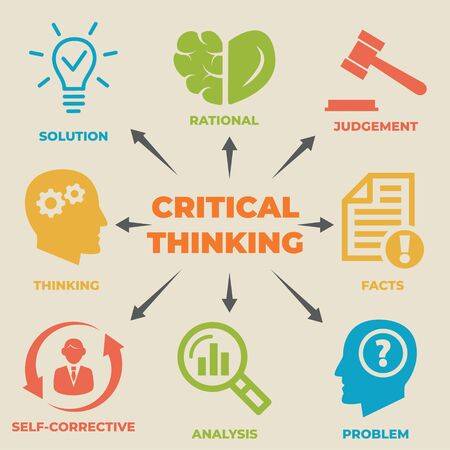Critical thinking is the analysis of available facts, evidence, observations, and arguments to form a sound judgment. Humans are naturally endowed with the ability to think or reason, however, the ability to make sound judgment or reasonable judgement depend on the ability to think critically- observing, analysing, explaining, making connections, and ending with a sound conclusion. Critical thinking has four main domains;
Discipline: In the context of critical thinking, discipline is the ability to subject your emotions under control when you have the ability to give a conclusion on something. Discipline in orderto look for further evidence before giving a judgement.
Clear: Ability to make sensible and sound decisions that brings understanding.
Rational: Ability to think outside the box, questioning and enquiring into details.
Open-minded: the willingness to search actively for evidence against one's favored beliefs, plans, or goals, and to weigh such evidence fairly when it is available.
Application of Critical Thinking: Since all humans make decisions day-in and day-out, it is crucial to make better decisions by thinking critically, Critical is applicable in all aspects of our life; personal life, family, business, political, science, workplace etc.
Critical Thinking Behaviours
• Ask questions
• Distinguish facts from opinions
• Seek multiple perspectives
• Recognise assumptions
• Give room for other people’s opinions
• Do not draw conclusions hastily
• Evaluate arguments for relevance and accuracy
• Use multiple sources of information
• Balance logic and emotions
• Use Criteria to evaluate information
• Consider all sides of an argument
• Avoid bias
• Present processes with diagrams to aid in understanding.
“Ten Commandaments of Logical reasoning”
Ad hominem (attacking someone’s image/character instead of the argument in question)
For example, ignoring the words of a drunkard because you think they are drunkards and therefore can’t make any better decision.
Straw man Fallacy (exaggerating a person’s argument so that you can make it easier to attack their argument). For example; telling a person they don’t care about you because they told you they are travelling without you for a long time.
Hasty Generalization (Drawing conclusions from using a small amount of information). For example; saying that all white people are mean because one white person was mean to you.
Begging the question (making conclusions because on of the premise of a situation is true). For example; saying that business students are better than engineering students because most business students graduate with a first class.
Post hoc/ false cause (concluding that the event that happened before a particular event is the cause of the latter). For example; saying that your baby spilled the milk because they were the last thing that passed before the milk poured out of the cup.
False dichotomy (reducing an argument to two possibilities, sometimes referred to as “either or”). For example; saying that your dad buys you an iPhone and if they decide not to, you conclude that they don’t love you.
Ad Ignorantiam (saying something is true or false because it hasn’t been proven otherwise). For example; saying that ghosts do not exist because you haven’t seen one before.
Burden of proof reversal (giving the burden to prove that your conclusion is true or false). For example; asking someone to disprove your conclusion that ghost do not exist.
Non sequitur (when there is no logical connection of your premise with your conclusion). For example; “snakes crawl, they are reptiles; therefore, all reptiles are snakes.
Bandwagon fallacy (drawing a conclusion from a popular premise). For example; saying that every student who goes to KNUST does good in engineering so it will be best for your friend who wants to study engineering to go KNUST.


